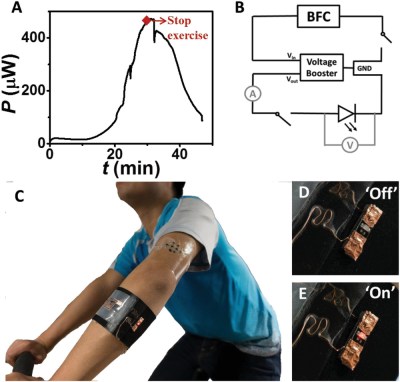Researchers from l’Université Grenoble Alpes and the University of San Diego recently developed and patented a flexible device that’s able to produce electrical energy from human sweat. The lactate/O2 biofuel cell has been demonstrated to light an LED, leading to further development in the area of harvesting energy through wearables.

Scientists have developed a flexible conductive material made up of carbon nanotubes, cross-linked polymers, and enzymes connected to each and printed through screen-printing. This type of composite is known as a buckypaper, and uses the carbon nanotubes as the electrode material.
The lactate oxidase works as the anode and the bilirubin oxidase (from the yellowish compound found in blood) as the cathode. Given the theoretical high power density of lactate, this technology has the potential to produce even more power than its current power generation of 450 µW.

At the moment, the biggest cost for production is the price of the enzymes that transform the compounds in sweat. Beyond cost considerations, the researchers also need to look at ways to increase the voltage in order to power larger portable devices.
With all the exciting research surrounding wearable technology right now, hopefully we’ll be hearing about further developments and applications from this research group soon!
[Thanks to Qes for the tip!]


















